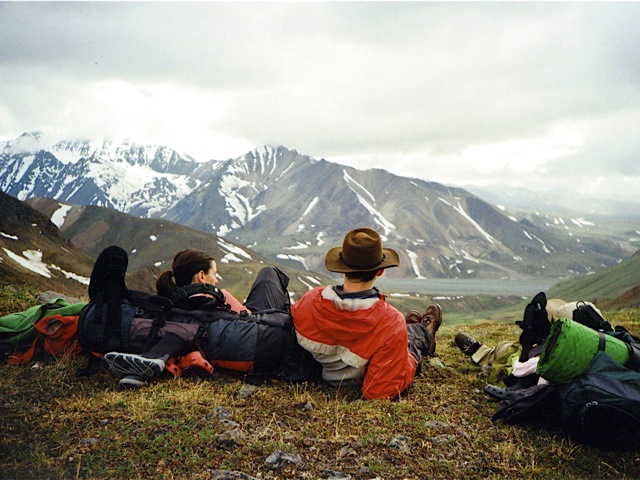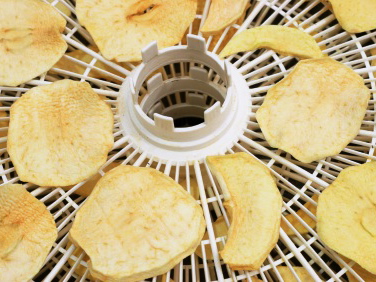
cooking, l
(article, Jennifer Kelly-DeWitt)
[%pageBreakSettings nobreak=true] This time last year, my husband and I were packing our bags for a weeklong hiking and camping trip in the backcountry of Alaska’s Denali National Park. Mike and I had been invited on the trip by our friends Nazgol and Alaska Jed, the latter so nicknamed because he’d once spent part of a summer in Alaska. The rest of us had once spent part of a weekend in California’s Coastal Range. And that about summed up our backpacking experience. Sure, we’d backpacked for a night or two at a time. On those trips, we’d blithely carried bottles of wine, fancy cheeses, and fresh vegetables and fruit. For us, backpacking was an extended picnic with vigorous exertions between meals. A full moon was the best sauce. But we would be in Denali for eight days and seven nights. It’s easy to condone lugging one block of Gruyère into the wilderness; seven hunks of Gruyère, however, is another order of schlepping — to say nothing of the wine bottles. Our backpacks came in non-negotiable sizes, as did our strength. In addition to food, we needed to carry cooking gear, sleeping gear, rain gear, safety gear, hygiene gear, and sundries. If we wanted our shoulders to remain higher than our knees, we needed to keep our food in check. One way to reduce food weight and volume on backpacking trips is to buy commercially processed, freeze-dried camping meals, which are sold in single-serving packages in most camping-supply stores. However, I was pretty sure I would die of the blahs, if not of sodium overload, eating freeze-dried pad Thai seven nights in a row. Denali is beautiful but arguably bleak, and hiking there promised to be arduous. I foresaw craving a little luxury, such as richly flavored food. Fortunately, backpacking predates astronaut ice cream. Thanks to a trip to the public library and some conversations with a knowledgeable friend, I learned how to reduce the food weight of my pack while still picnicking on fruit, vegetables, and homemade foods. [%image reference-image float=right width=400 caption="Apple slices dried in a home dehydrator."] The key was a food dehydrator. This simple machine can be either bought or made, depending on your degree of handiness and devotion to things DIY. In all its incarnations, a dehydrator is essentially a large box with multiple sliding drying racks. Commercially available versions have a plug-in fan and heat source, whereas DIY versions usually require rack rotation for circulation and can be solar powered. For my part, I was lucky enough to be able to borrow a commercially produced dehydrator from a friend, who’d found it at a garage sale. Food dehydrators evaporate 80 to 95 percent of the water from fruits, vegetables, soups, sauces, stews, and meats, dramatically reducing food weight and volume while also eliminating the risk of spoilage. Fresh, a zucchini will grow a beard in your pack and weigh on your hip belt. Julienned and dried, however, it will last for a year, be as light as confetti, and mix easily into stews, pastas, and pilafs, adding nutrition and flavor to one-pot meals. If you have the leisure and equipment for a two-pot meal, it’s even possible to cook an elegant ragout, combining that zucchini with other interesting dried vegetables and herbs. You can also keep greens in your diet by dehydrating the leaves of some of the hardier edible greens, such as chard, kale, and spinach, then braising them on the trail in water and olive oil — or, again, simply mixing them into a one-pot meal. As I prepared our menu for Denali, I experimented with drying many plausible vegetables. The results were mixed. In addition to zucchini and leafy greens, my most successful experiments were with carrots, string beans, peas, and beets. (On the trail, the beets loaned their rosy color to whatever one-pot meal we were eating that day, perking up the often-unremitting gray of Denali zones 6, 7, and 8.) Onions and garlic were easy to dry, but they emitted such overwhelming onion-and-garlic odors during the dehydration process — and are so widely available dried from commercial sources — that I would recommend against drying them at home. [%image cooking float=left width=400 caption="The Denali kitchen: A wall made of ice."] All of these vegetables took about 8 to 10 hours to dry when they were julienned or rough-cubed, so for the most part I was able to open the kitchen window, close the kitchen door, and run the dehydrator either all day while I worked or all night while I slept. Another staple of our Denali menu was pasta with tomato and mushroom sauce. A basic, even instinctual dish when made at home, pasta-and-sauce requires considerable foresight to make on the trail. The sauce’s high liquid content makes it unwieldy both by weight and by volume. If it spills inside a pack, you’ll have to live with the consequences for days or weeks. And then there’s the matter of food odor, a great concern in bear territory. Dried foods smell significantly less than fresh foods or liquids. The solution, I found, is to make a fairly viscous sauce that uses tomato paste in place of fresh or canned tomatoes, spread it evenly on plastic wrap as you would spread cooked fruit if making a fruit leather, and lay the plastic wrap on the racks of the dehydrator. The sauce then dries like a fruit leather and can be rolled up and wrapped in plastic until needed. The dried mushrooms for the sauce — store-bought or homemade — travel separately. On the trail, you cook a pot of pasta until it’s about three-quarters of the way to al dente (with about an inch of water covering the pasta) before adding the sauce leather and mushrooms. As the pasta finishes cooking, the leather will absorb the remaining pasta water and revert to a sauce form, the mushrooms will soften, and in minutes, you’ll be eating the backpacking version of comfort food. Non-vegetarians may wonder: Where’s the meat? The meat was Mike’s department. He undertook to turn three pounds of lean Niman Ranch flank steak into about 12 ounces of homemade beef jerky. His method was to slice the steak extremely thin, cutting across the grain of the meat; he partially froze the meat first, to make the slicing easier. [%image snacking float=right width=450 caption="A snack break while hiking in Alaska's Denali National Park."] Next he made a marinade: 2 tablespoons tamari, 1/4 teaspoon salt, four drops Tabasco, one minced garlic clove, and plenty of fresh ground pepper. (It seems like a small amount of tamari, but even a small amount of evaporated tamari is potently salty.) He marinated the steak in the fridge for two days, then dehydrated it for about 14 hours until it was brittle. Mike and Alaska Jed snacked happily on the Niman Ranch jerky throughout Denali, verbally denigrating the Slim Jims of gas stations past and adding the jerky to their individual bowls of pasta and sauce for a meat infusion. In the course of planning and preparing our Denali menu, I established a small camping-cooking reference library of books about food drying and backcountry cooking. The best of these were [%bookLink code=0394707745 "The Hungry Hiker’s Book of Good Cooking"], by Gretchen McHugh, the amusingly retro [%bookLink code=0961199806 "Dry It — You’ll Like It"], by Gen MacManiman, and the Sierra Club publication [%bookLink code=157805110X "Simple Foods for the Pack"], by Claudia Axcell, Diana Cooke, and Vicki Kath. (Other books include The Leave-No-Crumbs Camping Cookbook and Making and Using Dried Foods.) The first two books are especially focused on homemade dried fare and include instructions for DIY dehydrators, whereas the Sierra Club book has more of a focus on convenience and how to combine store-bought ingredients. I pulled information and recipes from all three in planning our Alaskan expedition. We ate well throughout our week in Denali, despite the challenges. Confident that our food would taste good and wouldn’t spoil, we were free to worry about being mauled by grizzlies and/or trampled by moose while we scrambled to fulfill our ambitious trekking schedule. [[block(sidebar). h1.Featured recipe]] Every day, we hiked from 9 a.m. till 11 p.m. or later. (Because it's so far north, summer in Alaska never gets dark.) Breakfasts and lunches were typically hurried affairs, consisting of some combination of oatmeal, tea, sweet trail mix, savory trail mix, nut butters, dried fruit, crackers, and chocolate. The evening meals were more gustatorially varied: pasta with sauce, mushroom bulgur, egg noodles with lentils and greens. Yet more often than not, we were so spent after the day’s exertions — and so cold in the midnight gloaming — that we didn't linger over dinner, either. The one exception to our harried hiking routine came on our last day in Denali. The night before, at close to midnight, we had reached the endpoint of our trek: a verdant tundra slope above the Toklat River. For one glorious sunny Denali day, Mike, Nazgol, and I lolled on the tundra, reading novels and snacking continually on jerky, dried kiwis, dried nectarines, cocoa-and-nut-butter confections, and the foraged leaves of edible tundra plants. Alaska Jed, true to his nickname, went on a day hike. That evening we dallied over the cooking and dined in leisurely fashion on mushroom bulgur, vegetable ragout, and almond cookies. The meal was richly flavored, and for an hour or so we savored our achievement, enjoying each other’s company and the spectacular scenery. Until the mosquitoes drove us into our tents. p(bio). Jennifer Kelly-Dewitt is a writer and teacher in the Bay Area. In the future, she hopes to backpack in grizzly-free wildernesses.

cooking, l

snacking, l

reference-image, l